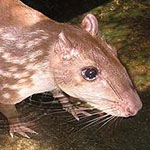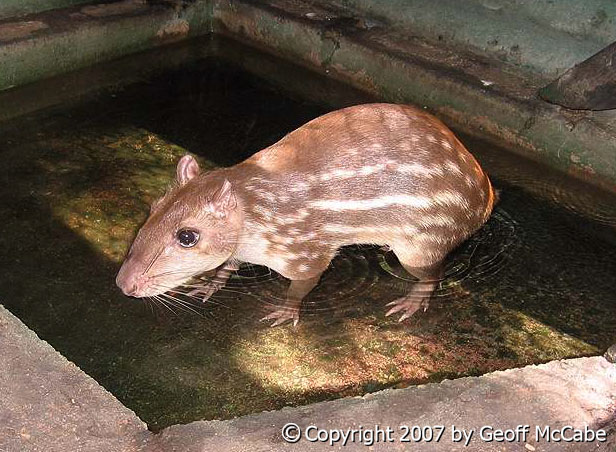- Home
- Accommodation
- Activities
- Area Info
- Maps
- Photo Galleries
- Real Estate
- Travel
Paca
Spanish Name: Tepesquintle
Found In: Moist lowland habitats or seasonal arid areas near permanent streams or water bodies. In Costa Rica, it is common in relatively undisturbed forest of up to 2,000 m in elevation. It is found in deciduous forests to wet tropical evergreen forests.
Height/Weight: The head and body length is approximately 60-80 cm; their short, vestigial tail is 2 cm long. They weigh about 10 kg. Adult males are usually 15% larger than adult females.
Life Span: About 16 years
The Paca is a close relative of the squirrel but is larger than the agouti, and is twice the agouti’s weight. It is mainly brown to black in color, with four lines of bright dots on both sides of its body. These are solitary creatures and are almost always by themselves with the exception of a mother raring her young one.
Pacas range from east Mexico until northern Paraguay. They prefer thick vegetation and densely forested regions and often collect near streams and other water sources. In Costa Rica, they are often seen scurrying around Arenal, Manuel Antonio, and sheltered areas of the Central Valley. In addition to this, they are also spotted in and around other national parks in Costa Rica where there is thick vegetation and plenty of fruits and seeds to feast on.
 Pacas are herbivores and prefer to dine on fruit – especially mango and guava. They also feed on seeds. Pacs do not consume hard seeds like their close counsins, the agoutis. When fruit is not available, the paca diet is reduced to seedlings.
Pacas are herbivores and prefer to dine on fruit – especially mango and guava. They also feed on seeds. Pacs do not consume hard seeds like their close counsins, the agoutis. When fruit is not available, the paca diet is reduced to seedlings.
Pacas like to eat in the dingiest and darkest corners in the forest. They are extremely adept at sprinting when encountered with dangers and have the useful skill of staying still for almost an hour if required. Apart from sprinting and staying still for avoiding danger, pacas have a thin outer layer of skin that can be easily missed by a predator, so it is quite a task to grasp them before they scoot. Another clever paca escape strategy is to submerge themselves inside water in the event of a potential threat.
To discourage potential predators, pacas also utilize vocal sounds and clench their teeth to make loud and sinister sounds. A male is also capable of roaring and putting up a fierce fight to defend his range. When a combat becomes necessary, pacas fight by standing head to head and gnawing each other with their big incisors. Like agoutis, male pacas mark prospective mates by spraying urine on them.

Mating season for the paca can vary considerably. The female Paca usually gives birth to one offspring after a gestation period of about 114 to 119 days. There is possibility that female may have multiple pregnancies during a year. The young ones have been recorded to stay with their mothers for approximately 3 months before venturing out independently.
The spotted paca is a nocturnal and solitary mammal, and is rarely seen in the day or spotted in large groups. It is also rare for them to make much noise (other than if they are provoked or threatened) as they are reasonably quieter animals. Pacas mostly live in forests, mainly in the vicinity of water bodies. They dig burrows which are approximately 7 feet long and below the ground. The spotted paca runs towards the river when threatened as they are excellent swimmers. Pacas eat fruits and other parts of the plant, their favorite being avocados.
The lowland paca’s status in the wild is threatened due to it being a pest it many parts of the country. The paca is known to destroy sugarcane, corn and other crops. These small mammals are also hunted for their delectable meat. Despite this, the paca has several protected reserves to breed in, and hence is not gravely affected by the prospect of extinction.
Pacas are monogamous in nature, and each couple shares an area of about 7.5 acres of land. Paca pairs often forage for food separately and stay apart. Mating occurs all through the year and begins when the male initiates a hop like dance ritual, complete with twists to spray urine on the female. The female will avoid the male at first, and may even take to attacking him, but eventually stoops low to the ground to celebrate his apporach. Pacas generally have one or two litters per year, and their gestation period averages about 3.5 months. Females usually give birth to a single offspring. While babies wean till 3 months, they live with the mother till fully grown. Paca females reach sexual maturity around nine months of age, while males become sexually active after a year. Their lifespan is 13 years in the wild.
Further Reading
http://costarica.com/wildlife/pacas/
http://eol.org/pages/326582/details
http://www.treeoflifecostarica.com/paca.php
Great Stuff

Clandestina Restaurant
My new favorite restaurant, Clandestina is not to be missed by food lovers staying anywhere near to Montezuma. Established in March 2015, Clandestina is the new kid on the block. The Oregon/Tico collaboration is a winner among locals and travelers alike, with artisan craft beers, made onsite by Butterfly Brewing Co. and delicious, exciting […]











